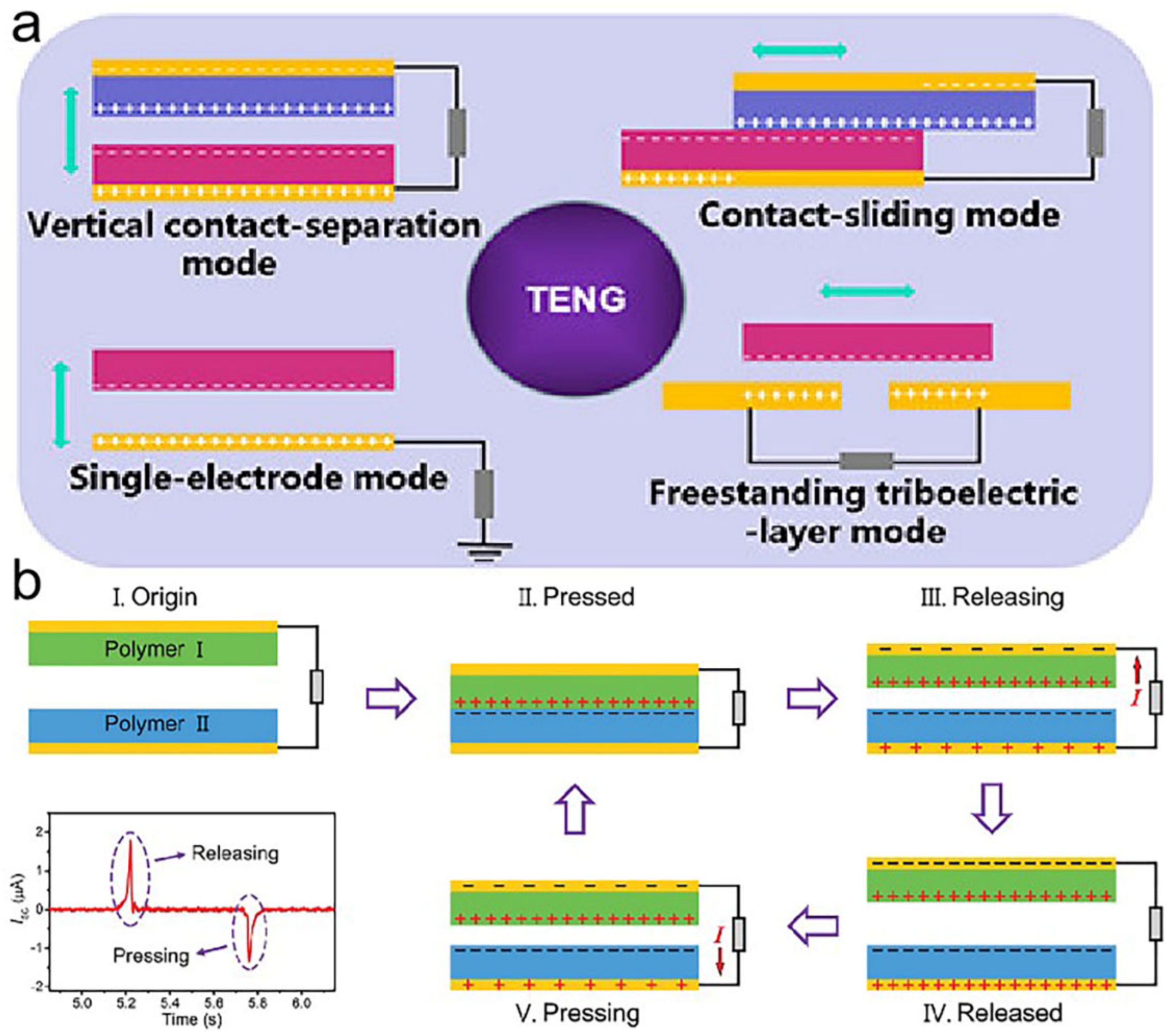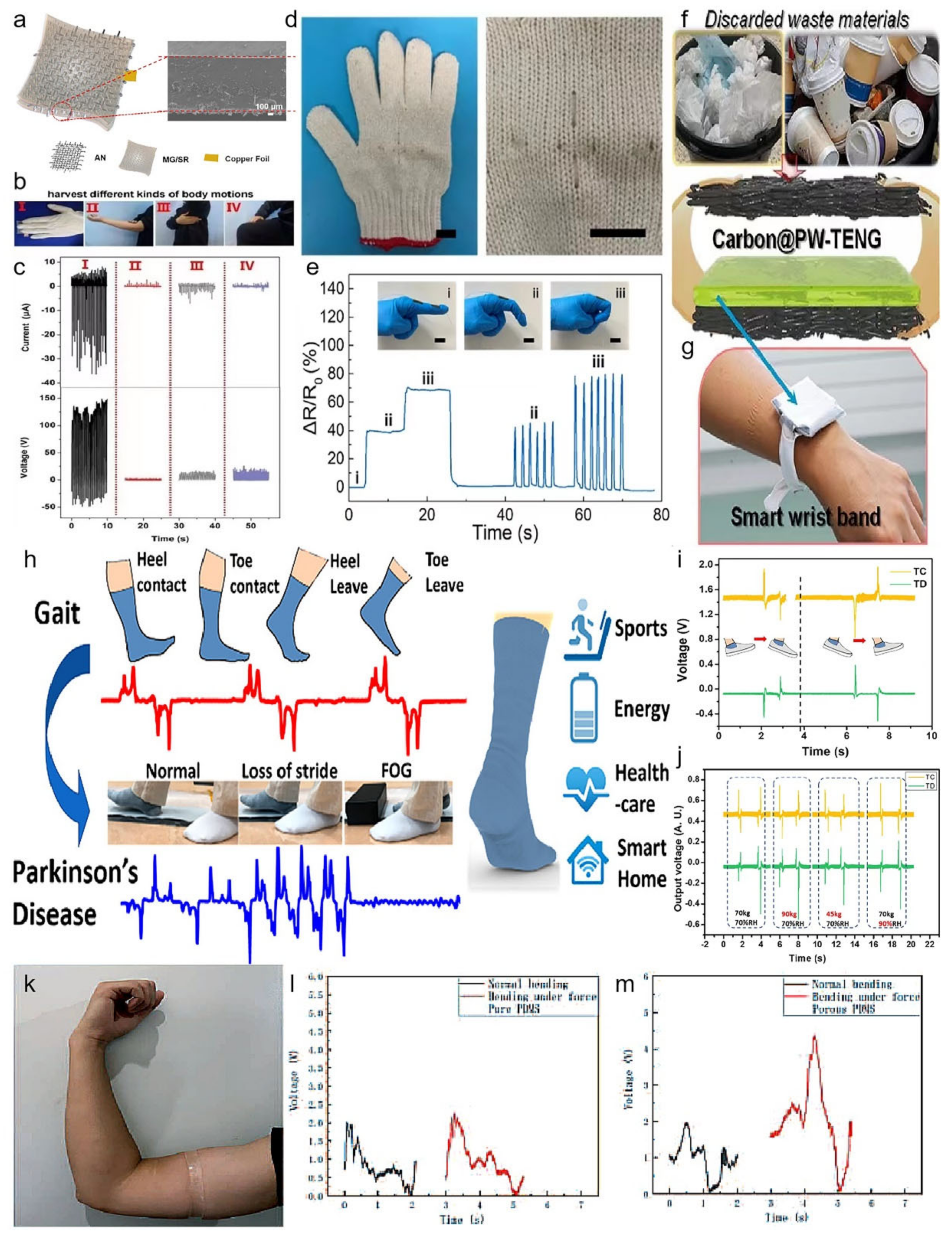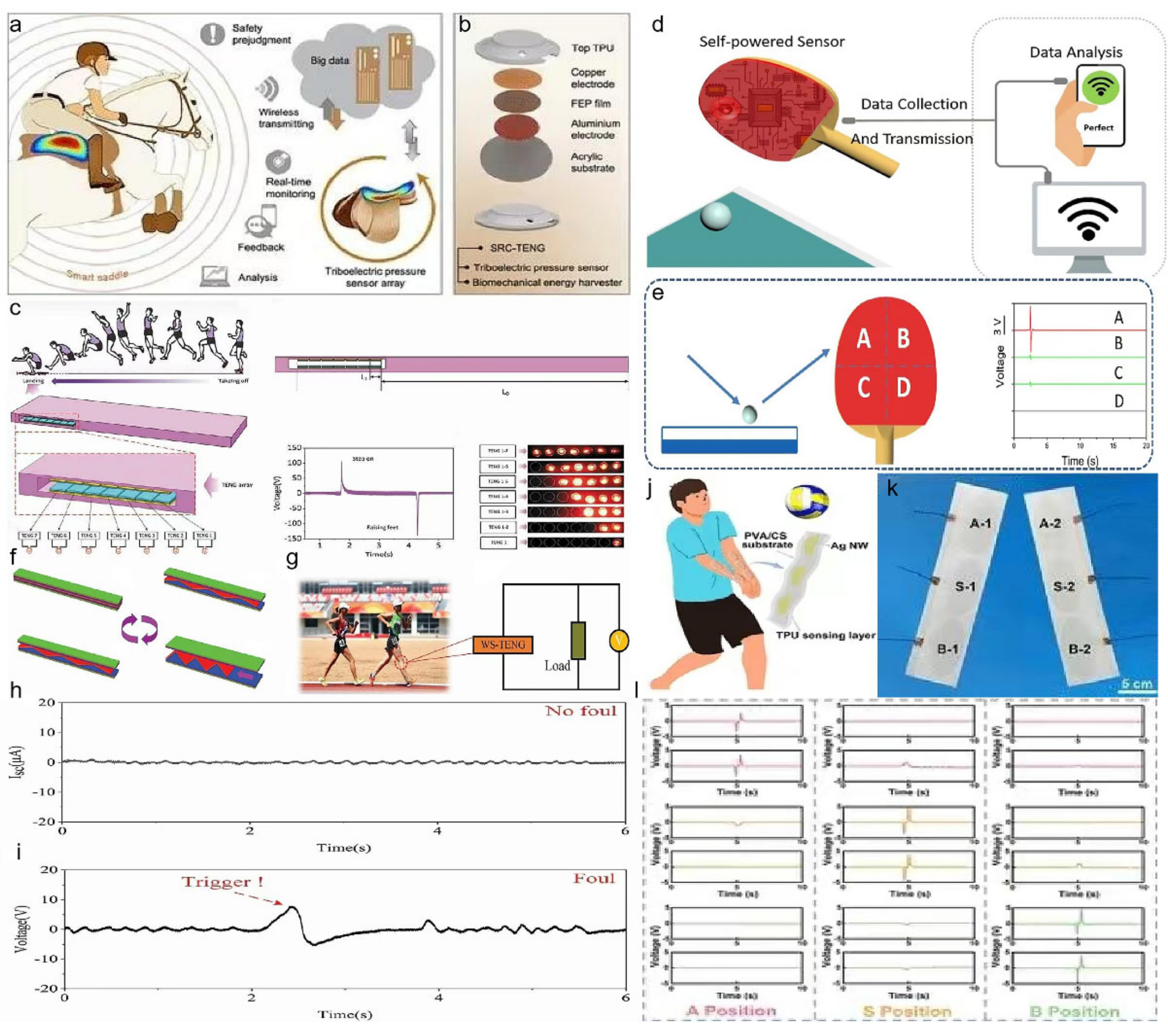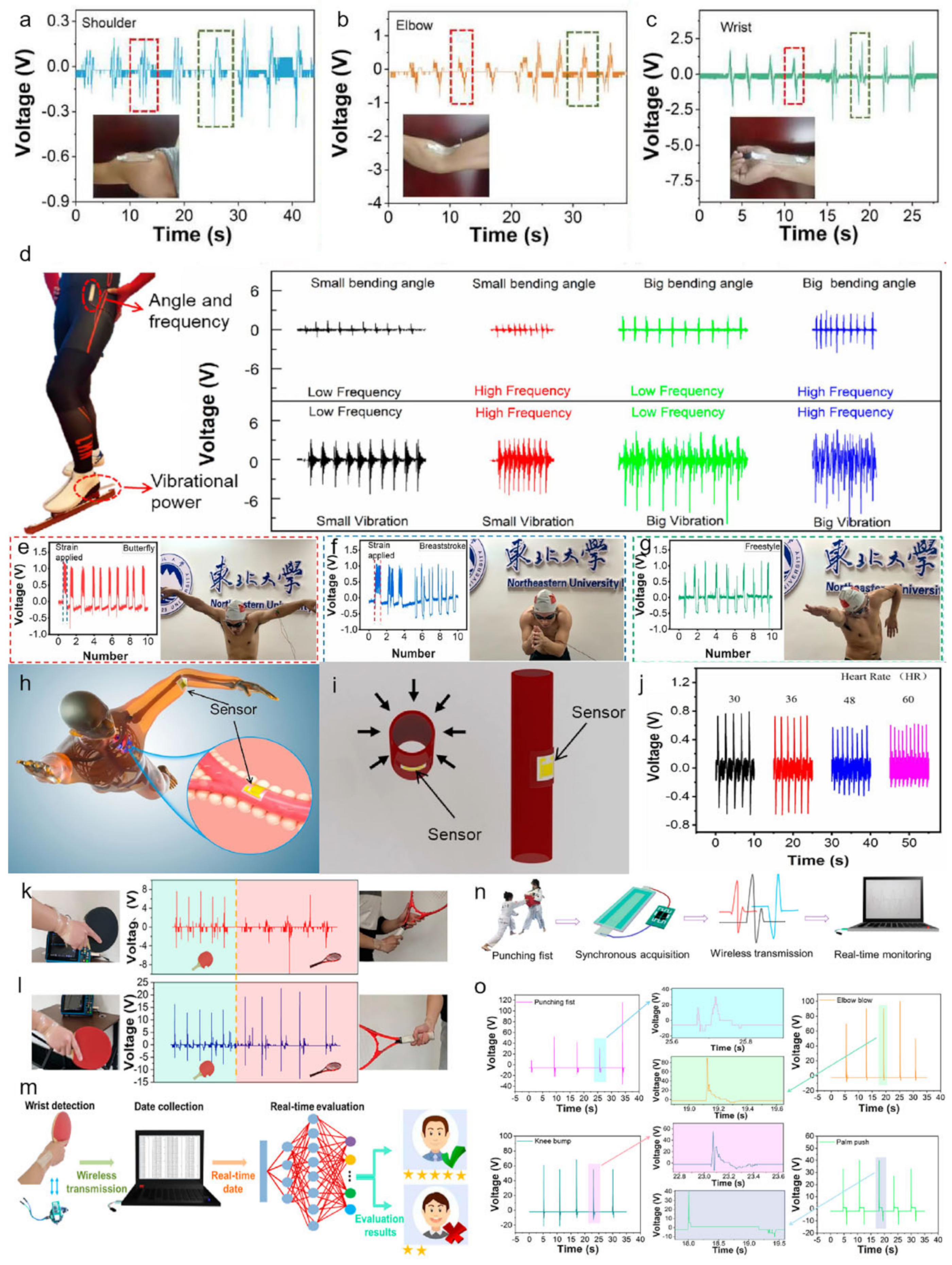Research Progress on Triboelectric Nanogenerator for Sports Applications
Abstract
1. Introduction
2. Triboelectric Nanogenerator
3. Research Progress of Wearable Energy Sensor Based on the TENG in the Sports Field
3.1. Basic Human Activity Monitoring
3.2. Energy Monitoring of Sports
4. Our Research Findings
5. Conclusions and Suggestions
5.1. Stability of Device
5.2. Universality of Material
5.3. Scientificity of Application
Funding
Institutional Review Board Statement
Informed Consent Statement
Data Availability Statement
Acknowledgments
Conflicts of Interest
References
- Luo, J.J.; Gao, W.C.; Wang, Z.L. The Triboelectric Nanogenerator as an Innovative Technology toward Intelligent Sports. Adv. Mater. 2021, 33, 2004178. [Google Scholar] [CrossRef] [PubMed]
- Zhang, P.C.; Zhang, Z.X.; Cai, J. A foot pressure sensor based on triboelectric nanogenerator for human motion monitoring. Microsyst. Technol. 2021, 27, 3507–3512. [Google Scholar] [CrossRef]
- Wang, C.; Hu, K.; Zhao, C.; Zou, Y.; Liu, Y.; Qu, X.; Jiang, D.; Li, Z.; Zhang, M.-R.; Li, Z. Customization of Conductive Elastomer Based on PVA/PEI for Stretchable Sensors. Small 2020, 16, 1904758. [Google Scholar] [CrossRef] [PubMed]
- Zhao, L.; Li, H.; Meng, J.; Li, Z. The recent advances in self-powered medical information sensors. InfoMat 2020, 2, 212–234. [Google Scholar] [CrossRef]
- Chen, J.; Huang, Y.; Zhang, N.; Zou, H.; Liu, R.; Tao, C.; Fan, X.; Wang, Z.L. Micro-cable structured textile for simultaneously harvesting solar and mechanical energy. Nat. Energy 2016, 1, 16138. [Google Scholar] [CrossRef]
- Liu, L.; Yu, Y.; Yan, C.; Li, K.; Zheng, Z. Wearable energy-dense and power-dense supercapacitor yarns enabled by scalable graphene-metallic textile composite electrodes. Nat. Commun. 2015, 6, 7260. [Google Scholar] [CrossRef]
- Pu, X.; Li, L.; Liu, M.; Jiang, C.; Du, C.; Zhao, Z.; Hu, W.; Wang, Z.L. Wearable Self-Charging Power Textile Based on Flexible Yarn Supercapacitors and Fabric Nanogenerators. Adv. Mater. 2016, 28, 98–105. [Google Scholar] [CrossRef]
- Pu, X.; Liu, M.; Li, L.; Han, S.; Li, X.; Jiang, C.; Du, C.; Luo, J.; Hu, W.; Wang, Z.L. Wearable Textile-Based In-Plane Microsupercapacitors. Adv. Energy Mater. 2016, 6, 1601254. [Google Scholar] [CrossRef]
- Yang, Y.; Hou, X.J.; Geng, W.P.; Mu, J.L.; Zhang, L.; Wang, X.D.; He, J.; Xiong, J.J.N.; Chou, X.J. Human movement monitoring and behavior recognition for intelligent sports using customizable and flexible triboelectric nanogenerator. Sci. China Technol. Sci. 2022, 65, 826–836. [Google Scholar] [CrossRef]
- Vo, C.P.; Shahriar, M.; Le, C.D.; Ahn, K.K. Mechanically Active Transducing Element Based on Solid-Liquid Triboelectric Nanogenerator for Self-Powered Sensing. Int. J. Precis. Eng. Manuf. Technol. 2019, 6, 741–749. [Google Scholar] [CrossRef]
- Su, M.; Brugger, J.; Kim, B. Simply Structured Wearable Triboelectric Nanogenerator Based on a Hybrid Composition of Carbon Nanotubes and Polymer Layer. Int. J. Precis. Eng. Manuf. Technol. 2020, 7, 683–698. [Google Scholar] [CrossRef]
- Wang, Y.; Jiang, J.; Zhang, H.; Dong, X.; Wang, L.; Ranjan, R.; Zomaya, A.Y. A scalable parallel algorithm for atmospheric general circulation models on a multi-core cluster. Future Gener. Comput. Syst.-Int. J. Esci. 2017, 72, 1–10. [Google Scholar] [CrossRef]
- Wang, Z.L.; Jiang, T.; Xu, L. Toward the blue energy dream by triboelectric nanogenerator networks. Nano Energy 2017, 39, 9–23. [Google Scholar] [CrossRef]
- Wang, Z.L.; Chen, J.; Lin, L. Progress in triboelectric nanogenerators as a new energy technology and self-powered sensors. Energy Environ. Sci. 2015, 8, 2250–2282. [Google Scholar] [CrossRef]
- Wang, Z.L. Triboelectric nanogenerators as new energy technology and self-powered sensors-Principles, problems and perspectives. Faraday Discuss. 2014, 176, 447–458. [Google Scholar] [CrossRef] [PubMed]
- Fan, F.-R.; Tian, Z.-Q.; Wang, Z.L. Flexible triboelectric generator! Nano Energy 2012, 1, 328–334. [Google Scholar] [CrossRef]
- Yang, H.M.; Wang, M.F.; Deng, M.M.; Guo, H.Y.; Zhang, W.; Yang, H.K.; Xi, Y.; Li, X.G.; Hu, C.G.; Wang, Z.L. A full-packaged rolling triboelectric-electromagnetic hybrid nanogenerator for energy harvesting and building up self-powered wireless systems. Nano Energy 2019, 56, 300–306. [Google Scholar] [CrossRef]
- Zhu, G.; Chen, J.; Zhang, T.; Jing, Q.; Wang, Z.L. Radial-arrayed rotary electrification for high performance triboelectric generator. Nat. Commun. 2014, 5, 3426. [Google Scholar] [CrossRef]
- Ouyang, H.; Liu, Z.; Li, N.; Shi, B.; Zou, Y.; Xie, F.; Ma, Y.; Li, Z.; Li, H.; Zheng, Q.; et al. Symbiotic cardiac pacemaker. Nat. Commun. 2019, 10, 1821. [Google Scholar] [CrossRef]
- Niu, S.; Wang, X.; Yi, F.; Zhou, Y.S.; Wang, Z.L. A universal self-charging system driven by random biomechanical energy for sustainable operation of mobile electronics. Nat. Commun. 2015, 6, 8975. [Google Scholar] [CrossRef]
- Yang, J.; Chen, J.; Su, Y.; Jing, Q.; Li, Z.; Yi, F.; Wen, X.; Wang, Z.; Wang, Z.L. Eardrum-Inspired Active Sensors for Self-Powered Cardiovascular System Characterization and Throat-Attached Anti-Interference Voice Recognition. Adv. Mater. 2015, 27, 1316–1326. [Google Scholar] [CrossRef] [PubMed]
- Wang, Z.L. Triboelectric Nanogenerators as New Energy Technology for Self-Powered Systems and as Active Mechanical and Chemical Sensors. ACS Nano 2013, 7, 9533–9557. [Google Scholar] [CrossRef]
- Lin, Z.; Chen, J.; Li, X.; Zhou, Z.; Meng, K.; Wei, W.; Yang, J.; Wang, Z.L. Triboelectric Nanogenerator Enabled Body Sensor Network for Self-Powered Human Heart-Rate Monitoring. ACS Nano 2017, 11, 8830–8837. [Google Scholar] [CrossRef] [PubMed]
- Heo, D.; Chung, J.; Shin, G.; Seok, M.; Lee, C.; Lee, S. Yo-Yo Inspired Triboelectric Nanogenerator. Energies 2021, 14, 1798. [Google Scholar] [CrossRef]
- Choi, Y.W.; Jang, S.; Chun, M.-S.; Kim, S.M.; Choi, M. Efficient Microfluidic Power Generator Based on Interaction between DI Water and Hydrophobic-Channel Surface. Int. J. Precis. Eng. Manuf. Technol. 2018, 5, 255–260. [Google Scholar] [CrossRef]
- Shi, M.; Zhang, J.; Chen, H.; Han, M.; Shankaregowda, S.A.; Su, Z.; Meng, B.; Cheng, X.; Zhang, H. Self-Powered Analogue Smart Skin. ACS Nano 2016, 10, 4083–4091. [Google Scholar] [CrossRef] [PubMed]
- Yi, F.; Lin, L.; Niu, S.; Yang, J.; Wu, W.; Wang, S.; Liao, Q.; Zhang, Y.; Wang, Z.L. Self-Powered Trajectory, Velocity, and Acceleration Tracking of a Moving Object/Body using a Triboelectric Sensor. Adv. Funct. Mater. 2014, 24, 7488–7494. [Google Scholar] [CrossRef]
- Zhang, H.; Yang, Y.; Su, Y.; Chen, J.; Adams, K.; Lee, S.; Hu, C.; Wang, Z.L. Triboelectric Nanogenerator for Harvesting Vibration Energy in Full Space and as Self- Powered Acceleration Sensor. Adv. Funct. Mater. 2014, 24, 1401–1407. [Google Scholar] [CrossRef]
- Lee, K.Y.; Yoon, H.-J.; Jiang, T.; Wen, X.; Seung, W.; Kim, S.-W.; Wang, Z.L. Fully Packaged Self-Powered Triboelectric Pressure Sensor Using Hemispheres-Array. Adv. Energy Mater. 2016, 6, 1502566. [Google Scholar] [CrossRef]
- Li, T.; Xu, Y.; Willander, M.; Xing, F.; Cao, X.; Wang, N.; Wang, Z.L. Lightweight Triboelectric Nanogenerator for Energy Harvesting and Sensing Tiny Mechanical Motion. Adv. Funct. Mater. 2016, 26, 4370–4376. [Google Scholar] [CrossRef]
- Wu, Z.; Ding, W.; Dai, Y.; Dong, K.; Wu, C.; Zhang, L.; Lin, Z.; Cheng, J.; Wang, Z.L. Self-Powered Multifunctional Motion Sensor a, Enabled by Magnetic-Regulated Triboelectric Nanogenerator. ACS Nano 2018, 12, 5726–5733. [Google Scholar] [CrossRef] [PubMed]
- Kim, J.E.; Kim, H.; Yoon, H.; Kim, Y.Y.; Youn, B.D. An Energy Conversion Model for Cantilevered Piezoelectric Vibration Energy Harvesters using Only Measurable Parameters. Int. J. Precis. Eng. Manuf. Technol. 2015, 2, 51–57. [Google Scholar] [CrossRef][Green Version]
- Yang, W.; Chen, J.; Jing, Q.; Yang, J.; Wen, X.; Su, Y.; Zhu, G.; Bai, P.; Wang, Z.L. 3D Stack Integrated Triboelectric Nanogenerator for Harvesting Vibration Energy. Adv. Funct. Mater. 2014, 24, 4090–4096. [Google Scholar] [CrossRef]
- Yang, Y.; Zhang, H.; Lin, Z.-H.; Zhou, Y.S.; Jing, Q.; Su, Y.; Yang, J.; Chen, J.; Hu, C.; Wang, Z.L. Human Skin Based Triboelectric Nanogenerators for Harvesting Biomechanical Energy and as Self-Powered Active Tactile Sensor System. ACS Nano 2013, 7, 9213–9222. [Google Scholar] [CrossRef]
- Zhu, G.; Yang, W.Q.; Zhang, T.; Jing, Q.; Chen, J.; Zhou, Y.S.; Bai, P.; Wang, Z.L. Self-Powered, Ultrasensitive, Flexible Tactile Sensors Based on Contact Electrification. Nano Lett. 2014, 14, 3208–3213. [Google Scholar] [CrossRef]
- Lu, Z.; Jia, C.; Yang, X.; Zhu, Y.; Sun, F.; Zhao, T.; Zhang, S.; Mao, Y. A Flexible TENG Based on Micro-Structure Film for Speed Skating Techniques Monitoring and Biomechanical Energy Harvesting. Nanomaterials 2022, 12, 1576. [Google Scholar] [CrossRef]
- Zhu, Y.; Sun, F.; Jia, C.; Zhao, T.; Mao, Y. A Stretchable and Self-Healing Hybrid Nano-Generator for Human Motion Monitoring. Nanomaterials 2022, 12, 104. [Google Scholar] [CrossRef] [PubMed]
- Pu, X.; Guo, H.; Chen, J.; Wang, X.; Xi, Y.; Hu, C.; Wang, Z.L. Eye motion triggered self-powered mechnosensational communication system using triboelectric nanogenerator. Sci. Adv. 2017, 3, e1700694. [Google Scholar] [CrossRef]
- Qian, Y.; Yu, J.; Zhang, F.; Kang, Y.; Su, C.; Pang, H. Facile synthesis of sub-10 nm ZnS/ZnO nanoflakes for high-performance flexible triboelectric nanogenerators. Nano Energy 2021, 88, 106256. [Google Scholar] [CrossRef]
- Qian, Y.; Lyu, Z.; Kim, D.-H.; Kang, D.J. Enhancing the output power density of polydimethylsiloxane-based flexible triboelectric nanogenerators with ultrathin nickel telluride nanobelts as a co-triboelectric layer. Nano Energy 2021, 90, 40527821. [Google Scholar] [CrossRef]
- Qian, Y.; Sohn, M.; He, W.; Park, H.; Subramanian, K.R.V.; Kang, D.J. A high-output flexible triboelectric nanogenerator based on polydimethylsiloxane/three-dimensional bilayer graphene/carbon cloth composites. J. Mater. Chem. A 2020, 8, 17150–17155. [Google Scholar] [CrossRef]
- Qian, Y.; Kang, D.J. Poly(dimethylsiloxane)/ZnO Nanoflakes/Three-Dimensional Graphene Heterostructures for High-Performance Flexible Energy Harvesters with Simultaneous Piezoelectric and Triboelectric Generation. ACS Appl. Mater. Interfaces 2018, 10, 32281–32288. [Google Scholar] [CrossRef] [PubMed]
- He, W.; Qian, Y.; Lee, B.S.; Zhang, F.; Rasheed, A.; Jung, J.-E.; Kang, D.J. Ultrahigh Output Piezoelectric and Triboelectric Hybrid Nanogenerators Based on ZnO Nanoflakes/Polydimethylsiloxane Composite Films. ACS Appl. Mater. Interfaces 2018, 10, 44415–44420. [Google Scholar] [CrossRef] [PubMed]
- Rasel, M.S.; Maharjan, P.; Rahman, M.T.; Salauddin, M.; Rana, S.M.S.; Lee, S.; Park, J.Y. Highly Responsive and Robust Micro-/Nano-Textured Self-Powered Triboelectric Humidity Sensor. ACS Appl. Electron. Mater. 2021, 3, 4376–4387. [Google Scholar] [CrossRef]
- Qu, M.; Shen, L.; Wang, J.; Zhang, N.; Pang, Y.; Wu, Y.; Ge, J.; Peng, L.; Yang, J.; He, J. Superhydrophobic, Humidity-Resistant, and Flexible Triboelectric Nanogenerators for Biomechanical Energy Harvesting and Wearable Self-Powered Sensing. ACS Appl. Nano Mater. 2022, 5, 9840–9851. [Google Scholar] [CrossRef]
- Chen, X.X.; Song, Y.; Chen, H.T.; Zhang, J.X.; Zhang, H.X. An ultrathin stretchable triboelectric nanogenerator with coplanar electrode for energy harvesting and gesture sensing. J. Mater. Chem. A 2017, 5, 12361–12368. [Google Scholar] [CrossRef]
- Zhang, L.; Su, C.; Cui, X.; Li, P.P.; Wang, Z.; Gu, L.; Tang, Z.X. Free-Standing Triboelectric Layer-Based Full Fabric Wearable Nanogenerator for Efficient Mechanical Energy Harvesting. ACS Appl. Electron. Mater. 2020, 2, 3366–3372. [Google Scholar] [CrossRef]
- Yang, Y.Q.; Sun, N.; Wen, Z.; Cheng, P.; Zheng, H.C.; Shao, H.Y.; Xia, Y.J.; Chen, C.; Lan, H.W.; Xie, X.K.; et al. Liquid-Metal-Based Super-Stretchable and Structure-Designable Triboelectric Nanogenerator for Wearable Electronics. ACS Nano 2018, 12, 2027–2034. [Google Scholar] [CrossRef]
- Li, H.; Zhang, Y.J.; Wu, Y.H.; Zhao, H.; Wang, W.C.; He, X.; Zheng, H.W. A stretchable triboelectric nanogenerator made of silver-coated glass microspheres for human motion energy harvesting and self-powered sensing applications. Beilstein J. Nanotechnol. 2021, 12, 402–412. [Google Scholar] [CrossRef] [PubMed]
- Wang, Y.F.; Jin, X.; Wang, W.Y.; Niu, J.R.; Zhu, Z.T.; Lin, T. Efficient Triboelectric Nanogenerator (TENG) Output Management for Improving Charge Density and Reducing Charge Loss. ACS Appl. Electron. Mater. 2021, 3, 532–549. [Google Scholar] [CrossRef]
- Matin Nazar, A.; Idala Egbe, K.-J.; Abdollahi, A.; Hariri-Ardebili, M.A. Triboelectric Nanogenerators for Energy Harvesting in Ocean: A Review on Application and Hybridization. Energies 2021, 14, 5600. [Google Scholar] [CrossRef]
- Peng, J.; Kang, S.D.; Snyder, G.J. Optimization principles and the figure of merit for triboelectric generators. Sci. Adv. 2017, 3, eaap8576. [Google Scholar] [CrossRef] [PubMed]
- Chen, C.; Guo, H.; Chen, L.; Wang, Y.-C.; Pu, X.; Yu, W.; Wang, F.; Du, Z.; Wang, Z.L. Direct Current Fabric Triboelectric Nanogenerator for Biomotion Energy Harvesting. ACS Nano 2020, 14, 4585–4594. [Google Scholar] [CrossRef] [PubMed]
- Li, S.; Zhong, Q.; Zhong, J.; Cheng, X.; Wang, B.; Hu, B.; Zhou, J. Cloth-Based Power Shirt for Wearable Energy Harvesting and Clothes Ornamentation. ACS Appl. Mater. Interfaces 2015, 7, 14912–14916. [Google Scholar] [CrossRef]
- Cao, R.; Pu, X.; Du, X.; Yang, W.; Wang, J.; Guo, H.; Zhao, S.; Yuan, Z.; Zhang, C.; Li, C.; et al. Screen-Printed Washable Electronic Textiles as Self-Powered Touch/Gesture Tribo-Sensors for Intelligent Human-Machine Interaction. ACS Nano 2018, 12, 5190–5196. [Google Scholar] [CrossRef]
- Zou, Y.; Raveendran, V.; Chen, J. Wearable triboelectric nanogenerators for biomechanical energy harvesting. Nano Energy 2020, 77, 105303. [Google Scholar] [CrossRef]
- Wang, H.; Han, M.; Song, Y.; Zhang, H. Design, manufacturing and applications of wearable triboelectric nanogenerators. Nano Energy 2021, 81, 105627. [Google Scholar] [CrossRef]
- Yi, F.; Zhang, Z.; Kang, Z.; Liao, Q.; Zhang, Y. Recent Advances in Triboelectric Nanogenerator-Based Health Monitoring. Adv. Funct. Mater. 2019, 29, 1808849. [Google Scholar] [CrossRef]
- Zu, G.Q.; Wei, Y.; Sun, C.Y.; Yang, X.J. Humidity-resistant, durable, wearable single-electrode triboelectric nanogenerator for mechanical energy harvesting. J. Mater. Sci. 2022, 57, 2813–2824. [Google Scholar] [CrossRef]
- Sun, L.J.; Huang, H.F.; Ding, Q.Y.; Guo, Y.F.; Sun, W.; Wu, Z.C.; Qin, M.L.; Guan, Q.B.; You, Z.W. Highly Transparent, Stretchable, and Self-Healable Ionogel for Multifunctional Sensors, Triboelectric Nanogenerator, and Wearable Fibrous Electronics. Adv. Fiber Mater. 2022, 4, 98–107. [Google Scholar] [CrossRef]
- Roy, S.; Maji, P.K.; Goh, K.-L. Sustainable design of flexible 3D aerogel from waste PET bottle for wastewater treatment to energy harvesting device. Chem. Eng. J. 2020, 413, 127409. [Google Scholar] [CrossRef]
- Li, M.J.; Cheng, W.Y.; Li, Y.C.; Wu, H.M.; Wu, Y.C.; Lu, H.W.; Cheng, S.L.; Li, L.; Chang, K.C.; Liu, H.J.; et al. Deformable, resilient, and mechanically-durable triboelectric nanogenerator based on recycled coffee waste for wearable power and self-powered smart sensors. Nano Energy 2020, 79, 105405. [Google Scholar] [CrossRef]
- Feng, X.; Li, Q.; Wang, K. Waste Plastic Triboelectric Nanogenerators Using Recycled Plastic Bags for Power Generation. ACS Appl. Mater. Interfaces 2021, 13, 400–410. [Google Scholar] [CrossRef] [PubMed]
- Yao, C.; Hernandez, A.; Yu, Y.; Cai, Z.; Wang, X. Triboelectric nanogenerators and power-boards from cellulose nanofibrils and recycled materials. Nano Energy 2016, 30, 103–108. [Google Scholar] [CrossRef]
- Dudem, B.; Dharmasena, R.D.I.G.; Riaz, R.; Vivekananthan, V.; Wijayantha, K.G.U.; Lugli, P.; Petti, L.; Silva, S.R.P. Wearable Triboelectric Nanogenerator from Waste Materials for Autonomous Information Transmission via Morse Code. ACS Appl. Mater. Interfaces 2022, 14, 5328–5337. [Google Scholar] [CrossRef]
- Zhu, M.L.; Shi, Q.F.; He, T.Y.Y.; Yi, Z.R.; Ma, Y.M.; Yang, B.; Chen, T.; Lee, C. Self-Powered and Self-Functional Cotton Sock Using Piezoelectric and Triboelectric Hybrid Mechanism for Healthcare and Sports Monitoring. ACS Nano 2019, 13, 1940–1952. [Google Scholar] [CrossRef]
- Hu, X.W.; Liu, L.; Xie, M.J.; Li, J.; Ou-Yang, W. High-Output Flexible Ring-Structure Triboelectric Nanogenerators for Wearable Electronics and Sports Monitoring. In Proceedings of the Photonics and Electromagnetics Research Symposium (PIERS), Hangzhou, China, 21–25 November 2021; pp. 1032–1039. [Google Scholar]
- Zhang, B.; Wu, Z.; Lin, Z.; Guo, H.; Chun, F.; Yang, W.; Wang, Z.L. All-in-one 3D acceleration sensor based on coded liquid-metal triboelectric nanogenerator for vehicle restraint system. Mater. Today 2021, 43, 37–44. [Google Scholar] [CrossRef]
- Ahmadi, A.; Mitchell, E.; Richter, C.; Destelle, F.; Gowing, M.; O’Connor, N.E.; Moran, K. Toward Automatic Activity Classification and Movement Assessment during a Sports Training Session. IEEE Internet Things J. 2015, 2, 23–32. [Google Scholar] [CrossRef]
- Luo, Y.; Zhao, T.; Dai, Y.; Li, Q.; Fu, H. Flexible nanosensors for non-invasive creatinine detection based on triboelectric nanogenerator and enzymatic reaction (vol 320, 112585, 2021). Sens. Actuators A Phys. 2021, 324, 112585. [Google Scholar] [CrossRef]
- Zhao, T.; Zheng, C.; He, H.; Guan, H.; Zhong, T.; Xing, L.; Xue, X. A self-powered biosensing electronic-skin for real-time sweat Ca2+ detection and wireless data transmission. Smart Mater. Struct. 2019, 28, 085015. [Google Scholar] [CrossRef]
- Bermon, S.; Hirschberg, A.L.; Kowalski, J.; Eklund, E. Serum androgen levels are positively correlated with athletic performance and competition results in elite female athletes. Br. J. Sports Med. 2018, 52, 1531–1532. [Google Scholar] [CrossRef] [PubMed]
- He, H.; Zhao, T.; Guan, H.; Zhong, T.; Zeng, H.; Xing, L.; Zhang, Y.; Xue, X. A water-evaporation-induced self-charging hybrid power unit for application in the Internet of Things. Sci. Bull. 2019, 64, 1409–1417. [Google Scholar] [CrossRef]
- Zhang, W.; Guan, H.; Zhong, T.; Zhao, T.; Xing, L.; Xue, X. Wearable Battery-Free Perspiration Analyzing Sites Based on Sweat Flowing on ZnO Nanoarrays. Nano-Micro Lett. 2020, 12, 105. [Google Scholar] [CrossRef]
- Nunes Rodrigues, A.C.; Pereira, A.S.; Sousa Mendes, R.M.; Araujo, A.G.; Couceiro, M.S.; Figueiredo, A.J. Using Artificial Intelligence for Pattern Recognition in a Sports Context. Sensors 2020, 20, 3040. [Google Scholar] [CrossRef] [PubMed]
- Zou, Y.J.; Libanori, A.; Xu, J.; Nashalian, A.; Chen, J. Triboelectric Nanogenerator Enabled Smart Shoes for Wearable Electricity Generation. Research 2020, 2020, 7158953. [Google Scholar] [CrossRef]
- He, C.; Zhu, W.J.; Chen, B.D.; Xu, L.; Jiang, T.; Han, C.B.; Gu, G.Q.; Li, D.C.; Wang, Z.L. Smart Floor with Integrated Triboelectric Nanogenerator as Energy Harvester and Motion Sensor. ACS Appl. Mater. Interfaces 2017, 9, 26126–26133. [Google Scholar] [CrossRef]
- Zhang, P.C.; Cai, J. A self-powered grip exerciser based on triboelectric nanogenerator for intelligent sports monitoring. Mater. Technol. 2021, 37, 753–759. [Google Scholar] [CrossRef]
- Shen, X.A.; Han, W.J.; Jiang, Y.F.; Ding, Q.J.; Li, X.; Zhao, X.; Li, Z.Y. Punching pores on cellulose fiber paper as the spacer of triboelectric nanogenerator for monitoring human motion. Energy Rep. 2020, 6, 2851–2860. [Google Scholar] [CrossRef]
- Peng, F.; Liu, D.; Zhao, W.; Zheng, G.; Ji, Y.; Dai, K.; Mi, L.; Zhang, D.; Liu, C.; Shen, C. Facile fabrication of triboelectric nanogenerator based on low-cost thermoplastic polymeric fabrics for large-area energy harvesting and self-powered sensing. Nano Energy 2019, 65, 104068. [Google Scholar] [CrossRef]
- Hao, Y.T.; Wen, J.; Gao, X.B.; Nan, D.; Pan, J.; Yang, Y.H.; Chen, B.D.; Wang, Z.L. Self-Rebound Cambered Triboelectric Nanogenerator Array for Self-Powered Sensing in Kinematic Analytics. Acs Nano 2022, 16, 1271–1279. [Google Scholar] [CrossRef]
- Liu, R.; Li, M.P. A textile-based triboelectric nanogenerator for long jump monitoring. Mater. Technol. 2022. [Google Scholar] [CrossRef]
- Ma, X.F.; Liu, X.; Li, X.X.; Ma, Y.F. Light-Weight, Self-Powered Sensor Based on Triboelectric Nanogenerator for Big Data Analytics in Sports. Electronics 2021, 10, 2322. [Google Scholar] [CrossRef]
- Zou, Y.; Tan, P.; Shi, B.; Ouyang, H.; Jiang, D.; Liu, Z.; Li, H.; Yu, M.; Wang, C.; Qu, X.; et al. A bionic stretchable nanogenerator for underwater sensing and energy harvesting. Nat. Commun. 2019, 10, 2695. [Google Scholar] [CrossRef]
- Gogurla, N.; Roy, B.; Park, J.-Y.; Kim, S. Skin-contact actuated single-electrode protein triboelectric nanogenerator and strain sensor for biomechanical energy harvesting and motion sensing. Nano Energy 2019, 62, 674–681. [Google Scholar] [CrossRef]
- Qi, K.; He, J.; Wang, H.; Zhou, Y.; You, X.; Nan, N.; Shao, W.; Wang, L.; Ding, B.; Cui, S. A Highly Stretchable Nanofiber-Based Electronic Skin with Pressure-, Strain-, and Flexion-Sensitive Properties for Health and Motion Monitoring. ACS Appl. Mater. Interfaces 2017, 9, 42951–42960. [Google Scholar] [CrossRef] [PubMed]
- Wang, Z.; Gao, W.Y. A wave structure triboelectric nanogenerator for race walking motion sensing. Mater. Technol. 2022. [Google Scholar] [CrossRef]
- Shi, Y.P.; Wei, X.L.; Wang, K.M.; He, D.D.; Yuan, Z.H.; Xu, J.H.; Wu, Z.Y.; Wang, Z.L. Integrated All-Fiber Electronic Skin Toward Self-Powered Sensing Sports Systems. ACS Appl. Mater. Interfaces 2021, 13, 50329–50337. [Google Scholar] [CrossRef]
- Jia, C.; Zhu, Y.; Sun, F.; Zhao, T.; Xing, R.; Mao, Y.; Zhao, C. A Flexible and Stretchable Self-Powered Nanogenerator in Basketball Passing Technology Monitoring. Electronics 2021, 10, 2584. [Google Scholar] [CrossRef]
- Lu, Z.; Zhu, Y.; Jia, C.; Zhao, T.; Bian, M.; Jia, C.; Zhang, Y.; Mao, Y. A Self-Powered Portable Flexible Sensor of Monitoring Speed Skating Techniques. Biosensors 2021, 11, 108. [Google Scholar] [CrossRef]
- Mao, Y.; Zhu, Y.; Zhao, T.; Jia, C.; Bian, M.; Li, X.; Liu, Y.; Liu, B. A Portable and Flexible Self-Powered Multifunctional Sensor for Real-Time Monitoring in Swimming. Biosensors 2021, 11, 147. [Google Scholar] [CrossRef]
- Mao, Y.; Sun, F.; Zhu, Y.; Jia, C.; Zhao, T.; Huang, C.; Li, C.; Ba, N.; Che, T.; Chen, S. Nanogenerator-Based Wireless Intelligent Motion Correction System for Storing Mechanical Energy of Human Motion. Sustainability 2022, 14, 6944. [Google Scholar] [CrossRef]
- Sun, F.; Zhu, Y.; Jia, C.; Ouyang, B.; Zhao, T.; Li, C.; Ba, N.; Li, X.; Chen, S.; Che, T.; et al. A Flexible Lightweight Triboelectric Nanogenerator for Protector and Scoring System in Taekwondo Competition Monitoring. Electronics 2022, 11, 1306. [Google Scholar] [CrossRef]
- Zhao, T.; Fu, Y.; Sun, C.; Zhao, X.; Jiao, C.; Du, A.; Wang, Q.; Mao, Y.; Liu, B. Wearable biosensors for real-time sweat analysis and body motion capture based on stretchable fiber-based triboelectric nanogenerators. Biosens. Bioelectron. 2022, 205, 114115. [Google Scholar] [CrossRef] [PubMed]
- Park, J.H.; Wu, C.; Sung, S.; Kim, T.W. Ingenious use of natural triboelectrification on the human body for versatile applications in walking energy harvesting and body action monitoring. Nano Energy 2019, 57, 872–878. [Google Scholar] [CrossRef]
- Yang, D.; Ni, Y.; Kong, X.; Li, S.; Chen, X.; Zhang, L.; Wang, Z.L. Self-Healing and Elastic Triboelectric Nanogenerators for Muscle Motion Monitoring and Photothermal Treatment. ACS Nano 2021, 15, 14653–14661. [Google Scholar] [CrossRef]




| Devices | Humidity Resistance | Self-Healing | Breathability | Electrical Output | Applications |
|---|---|---|---|---|---|
| Textile-TENG (Zhu et al. [59]) | √ | ~200 V | green electronics | ||
| ITENG (Sun et al. [60]) | √ | ~115 V | wearable electronics, E-skin, and soft robotics | ||
| C@PW-TENG (Bhaskar et al. [65]) | √ | ~174 V | emergency communication device | ||
| S2-sock (Zhu et al. [66]) | √ | √ | ~196 V | smart home, sports monitoring, healthcare | |
| FR-TENG (Hu et al. [67]) | √ | ~100 V | health monitoring, self-powered system and human-machine interaction |
| Devices | Humidity Resistance | Self-Healing | Breathability | Foldability | Biocompatibility | Antibacterial | Electrical Output | Applications |
|---|---|---|---|---|---|---|---|---|
| SRC-TENG (Hao et al. [81]) | √ | ~55 V | intelligent athletic facilities, and sport safety | |||||
| CC-TENG (Liu et al. [82]) | √ | ~400 V | sports training and intelligent sports | |||||
| PP-TENG (Ma et al. [83]) | √ | ~6.05 V | intelligent athletic facilities and big data analytics | |||||
| WS-TENG (Wang et al. [87]) | √ | ~420 V | athlete monitoring system | |||||
| E-Skin (Shi et al. [88]) | √ | √ | √ | no clear data | wearable sports electronic device |
| Devices | Portability | Sensitivity | Humidity Resistance | Anticorrosion | Biocompatibility | Non-Invasiveness | Electrical Output | Applications |
|---|---|---|---|---|---|---|---|---|
| TSB-PENG (Jia et al. [89]) | √ | √ | √ | √ | √ | affected by many factors | sports training monitoring | |
| Sensor (Lu et al. [90]) | √ | √ | √ | √ | big data and IoT technologies in the sport industry | |||
| Biosensor (Mao et al. [91]) | √ | √ | √ | √ | √ | human–computer interaction and wireless sport big data | ||
| Motion Correction System-FL-TENG (Mao et al. [92]) | √ | √ | √ | intelligence sport big data and human–computer interaction | ||||
| Protector and Scoring System-FL-TENG (Sun et al. [93]) | √ | √ | √ | sports competition monitoring |
Publisher’s Note: MDPI stays neutral with regard to jurisdictional claims in published maps and institutional affiliations. |
© 2022 by the authors. Licensee MDPI, Basel, Switzerland. This article is an open access article distributed under the terms and conditions of the Creative Commons Attribution (CC BY) license (https://creativecommons.org/licenses/by/4.0/).
Share and Cite
Li, C.; Zhu, Y.; Sun, F.; Jia, C.; Zhao, T.; Mao, Y.; Yang, H. Research Progress on Triboelectric Nanogenerator for Sports Applications. Energies 2022, 15, 5807. https://doi.org/10.3390/en15165807
Li C, Zhu Y, Sun F, Jia C, Zhao T, Mao Y, Yang H. Research Progress on Triboelectric Nanogenerator for Sports Applications. Energies. 2022; 15(16):5807. https://doi.org/10.3390/en15165807
Chicago/Turabian StyleLi, Caixia, Yongsheng Zhu, Fengxin Sun, Changjun Jia, Tianming Zhao, Yupeng Mao, and Haidong Yang. 2022. "Research Progress on Triboelectric Nanogenerator for Sports Applications" Energies 15, no. 16: 5807. https://doi.org/10.3390/en15165807
APA StyleLi, C., Zhu, Y., Sun, F., Jia, C., Zhao, T., Mao, Y., & Yang, H. (2022). Research Progress on Triboelectric Nanogenerator for Sports Applications. Energies, 15(16), 5807. https://doi.org/10.3390/en15165807









